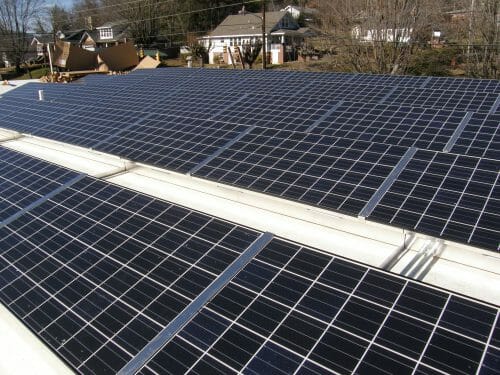Designing a Business – Inspired By Nature Part 2
Clean Energy and Carbon Management
100% of the electricity used in the manufacturing of Bark House® Poplar Shingles and Wall Coverings is renewable solar power, generated at this facility. 90% of the materials are sourced within 50 miles and 100% within 500 miles. Bark House manufacturing methods are clean and rely heavily on fine hand-crafting.
The CO2 emissions that are generated throughout the entire poplar bark supply chain and the on-site manufacturing are offset because bark locks in carbon (calculated by dry material weight). Bark is now being used in buildings, as opposed to biodegrading in nature. If a tree rots naturally then one of the final stages is microbial decomposition. This is a methanogenic process that produces methane gas (CH4). CH4 has an impact that is 25 times greater than CO2 pound for pound at causing climate change, according to the EPA. Our vendors are made up of small crews and small crews have a lighter impact in the forest as researched by the Land Conservation Foundation in Virginia. Crews log small tracts – usually no greater than 10 acres in any given area. The process of harvesting the material is largely performed with human energy.

Trees, wood products and bark are carbon storage experts.
For more on this, read the excerpt below from Chad Oliver of the Global Institute of Sustainable Forestry at the Yale School of Forestry & Environmental Studies, as printed in EE News:
WHY “CLEAN ENERGY AND CARBON MANAGEMENT” IS A SIGNIFICANT ISSUE TODAY
Carbon sequestration, urbanized
Beyond the intellectual challenges it offers to architects, there’s a powerful climate argument behind expanding the role of wood, advocates say.
“It’s an argument in two parts,” said Chad Oliver, director of the Global Institute of Sustainable Forestry at the Yale School of Forestry & Environmental Studies (F&ES). “First, when you build with wood, you’re storing carbon” — which counts for about half of wood’s dry weight — “away for a long time.” Assuming new trees grow to replace those that have been harvested, that’s a net carbon reduction, he said.
But the more compelling climate case is that wood could offset concrete and steel, both of which heavily contribute to global greenhouse gas emissions, he said.
Manufacturing the latter materials requires a lot of energy. Estimates by F&ES put the annual energy costs of steel, concrete and brick at 16 percent of total global fossil fuel consumption. The manufacture of cement, the primary ingredient in concrete, accounts for about 5 percent of annual global greenhouse gas emissions; manufacturing steel has a similar footprint.
And with huge infrastructural build-outs expected over the coming decades, the greenhouse gas footprint from these industries could be massive, Oliver said.
“Of all the infrastructure we’re going to need by 2050, only about 35 percent exists today,” he said. “That means almost twice as much has yet to be built. What are we going to build it out of?” These questions could have serious consequences for the climate, he added…
Can you save the forest for the trees?
As a carbon sink, the world’s forests are invaluable. Annual forest growth sequesters around 4 gigatons of carbon every year, while the total amount of carbon stocked in Earth’s forest cover is estimated at 1,200 gigatons — about twice the levels present in the atmosphere.
It might seem counterintuitive, then, to push for increased harvest as a way to fight climate change. But the vast majority of trees lost each year aren’t harvested for timber products but are cleared to make room for agriculture or burned as a low-efficiency fuel source.
Oliver, who led a recent study on the life cycle analysis of wood as a building material, said that forest regrowth far outpaces the needs of the timber industry. Harvesting wood for products offsets about 20 percent of annual forest growth, he said. Far more forest is lost to agricultural development — so much so that deforestation accounts for about a quarter of the world’s net carbon surplus.
“Harvesting more wood could actually strengthen the argument for biodiversity,” he said. “We need to appreciate the resource and protect it.” Sustainable forest management practices that targeted younger, smaller trees could even contribute to forest health, he said, as many U.S. forests are currently overgrown.
The analysis found that between 14 and 31 percent of global greenhouse gas emissions could be avoided by increasing the use of wood in buildings and infrastructure, both by sequestering carbon and offsetting the production of other materials.
Since 1990, The Bark House® has been changing the nature of buildings.
Impacts: People- Planet- Prosperity
 |
 |
 |
 |
 |
 |
